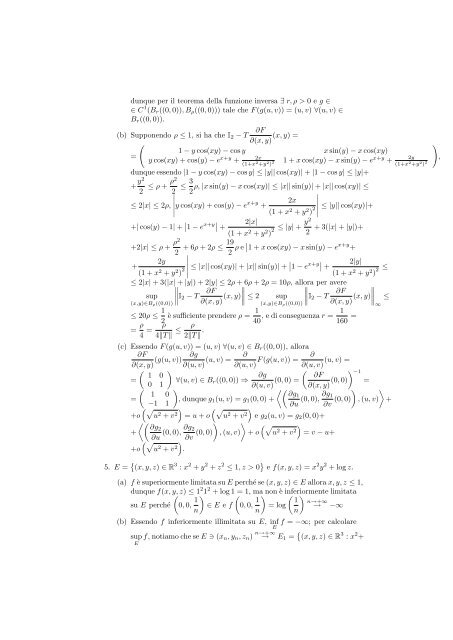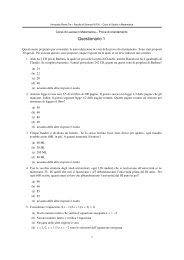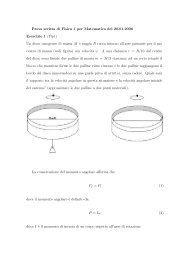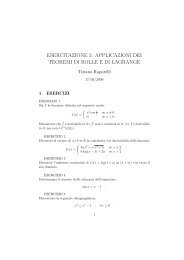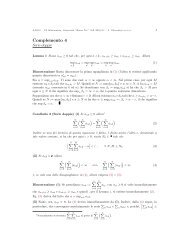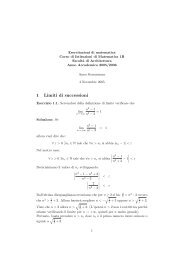Tutorato di Analisi 3 - Dipartimento di Matematica
Tutorato di Analisi 3 - Dipartimento di Matematica
Tutorato di Analisi 3 - Dipartimento di Matematica
Create successful ePaper yourself
Turn your PDF publications into a flip-book with our unique Google optimized e-Paper software.
dunque per il teorema della funzione inversa ∃ r, ρ > 0 e g ∈<br />
∈ C 1 (B r ((0, 0)), B ρ ((0, 0))) tale che F (g(u, v)) = (u, v) ∀(u, v) ∈<br />
B r ((0, 0)).<br />
(b) Supponendo ρ ≤ 1, si ha che I 2 − T<br />
∂F (x, y) =<br />
(<br />
∂(x, y)<br />
1 − y cos(xy) − cos y x sin(y) − x cos(xy)<br />
=<br />
y cos(xy) + cos(y) − e x+y 2x<br />
+<br />
1 + x cos(xy) − x sin(y) − e x+y +<br />
(1+x 2 +y 2 ) 2<br />
dunque essendo |1 − y cos(xy) − cos y| ≤ |y|| cos(xy)| + |1 − cos y| ≤ |y|+<br />
+ y2<br />
2 ≤ ρ + ρ2<br />
2 ≤ 3 ρ, |x sin(y) − x cos(xy)| ≤ |x|| sin(y)| + |x|| cos(xy)| ≤<br />
2 ∣ ≤ 2|x| ≤ 2ρ,<br />
∣ y cos(xy) + cos(y) − 2x ∣∣∣∣ ex+y +<br />
(1 + x 2 + y 2 ) 2 ≤ |y|| cos(xy)|+<br />
+| cos(y) − 1| + ∣ ∣1 − e x+y∣ ∣<br />
2|x|<br />
y2<br />
+<br />
(1 + x 2 + y 2 2<br />
≤ |y| + + 3(|x| + |y|)+<br />
) 2<br />
+2|x| ≤ ρ + ρ2<br />
2 + 6ρ + 2ρ ≤ 19 2 ρ e ∣ 1 + x cos(xy) − x sin(y) − e x+y +<br />
∣<br />
2y ∣∣∣∣<br />
+<br />
(1 + x 2 + y 2 ) 2 ≤ |x|| cos(xy)| + |x|| sin(y)| + ∣ ∣ 1 − e<br />
x+y 2|y| +<br />
(1 + x 2 + y 2 ) 2 ≤<br />
≤ 2|x| + 3(|x| + |y|) + 2|y| ≤ 2ρ + 6ρ + 2ρ = 10ρ, allora per avere<br />
sup<br />
∥ I 2 − T<br />
∂F ∥ ∥∥∥<br />
∂(x, y) (x, y) ≤ 2 sup<br />
∥ I 2 − T<br />
∂F ∥ ∥∥∥∞<br />
∂(x, y) (x, y) ≤<br />
(x,y)∈B ρ((0,0))<br />
(x,y)∈B ρ((0,0))<br />
≤ 20ρ ≤ 1 1<br />
1<br />
è sufficiente prendere ρ = , e <strong>di</strong> conseguenza r =<br />
2 40 160 =<br />
= ρ 4 = ρ<br />
4‖T ‖ ≤ ρ<br />
2‖T ‖ .<br />
(c) Essendo F (g(u, v)) = (u, v) ∀(u, v) ∈ B r ((0, 0)), allora<br />
∂F<br />
∂g<br />
(g(u, v)) (u, v) =<br />
∂ F (g(u, v)) =<br />
∂ (u, v) =<br />
∂(x, y) ∂(u, v) ∂(u, v) ∂(u, v)<br />
( ) 1 0<br />
=<br />
∀(u, v) ∈ B<br />
0 1<br />
r ((0, 0)) ⇒<br />
∂g (<br />
) −1 ∂F<br />
∂(u, v) (0, 0) = ∂(x, y) (0, 0) =<br />
( )<br />
〈( 1 0<br />
∂g1<br />
=<br />
, dunque g<br />
−1 1<br />
1 (u, v) = g 1 (0, 0) +<br />
∂u (0, 0), ∂g ) 〉<br />
1<br />
∂v (0, 0) , (u, v) +<br />
(√ ) (√ )<br />
+o u2 + v 2 = u + o u2 + v 2 e g 2 (u, v) = g 2 (0, 0)+<br />
〈( ∂g2<br />
+<br />
∂u (0, 0), ∂g ) 〉 (√ )<br />
2<br />
∂v (0, 0) , (u, v) + o u2 + v 2 = v − u+<br />
(√ )<br />
+o u2 + v 2 .<br />
5. E = { (x, y, z) ∈ R 3 : x 2 + y 2 + z 2 ≤ 1, z > 0 } e f(x, y, z) = x 2 y 2 + log z.<br />
(a) f è superiormente limitata su E perché se (x, y, z) ∈ E allora x, y, z ≤ 1,<br />
dunque f(x, y, ( z) ≤ 1 2 1 2 + log 1 = 1, ma non è inferiormente limitata<br />
su E perché 0, 0, 1 ) (<br />
∈ E e f 0, 0, 1 ) ( 1 n→+∞<br />
= log → −∞<br />
n<br />
n n)<br />
(b) Essendo f inferiormente illimitata su E, inf f = −∞; per calcolare<br />
E<br />
sup f, notiamo che se E ∋ (x n , y n , z n ) n→+∞<br />
→ E 1 = { (x, y, z) ∈ R 3 : x 2 +<br />
E<br />
)<br />
2y ,<br />
(1+x 2 +y 2 ) 2


